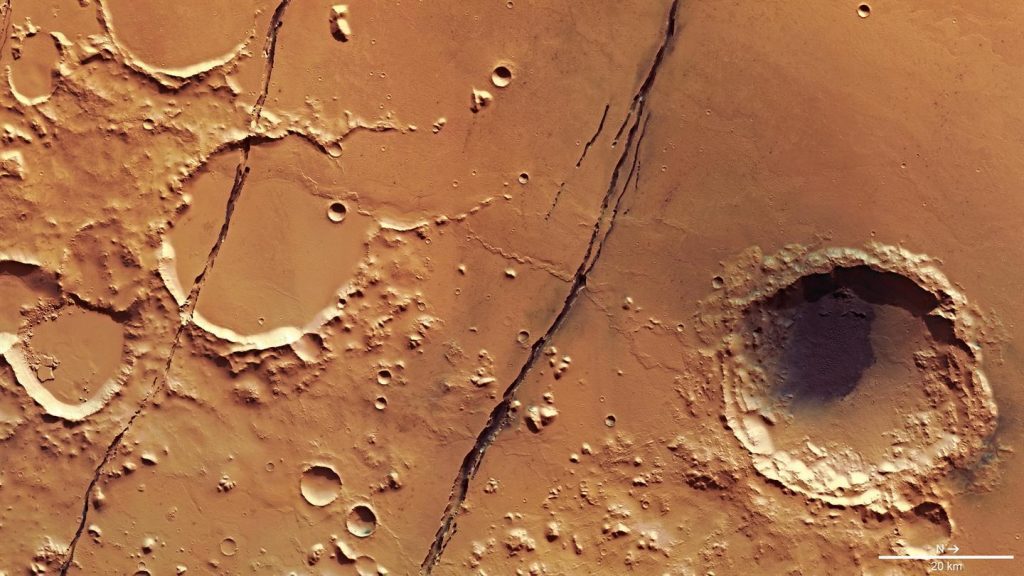three Sciences InSight’s seismic results are reported, which tell us the depth and composition of Mars’ crust and mantle and report that the planet’s core has melted. Before the lander touchdown in 2018, rover vehicles and orbital units studied the planet’s surface the most; This is altered by the patiently waiting InSight seismometer, which gives us a glimpse into the deepest structure on the planet for the first time.
The outer layer of the earth’s core also melts, while the solid inside. Additional measurements from InSight will attempt to discover, among other things, whether the same is true of Mars. When the InSight concept was devised for more than a decade, the main goal was to just publish the results, said Bruce Banerdt (NASA JPL), a senior researcher at InSight. The three articles published now exemplify the fruits of all the work and interests of the past decade, which means InSight has officially become a successful mission.
Seismometer InSight (SEIS – Seismic experiment of the internal structure) So far 733 earthquakes, the results presented in the articles have been derived from about 35 earthquakes of magnitude 3.0 to 4.0. Thanks to the amazingly sensitive instrument, researchers can “hear” the earthquake from hundreds of thousands of kilometers away.
The speed and shape of seismic waves that travel inside the planet change as they travel through different materials. Through these changes, seismologists can map the internal structure of the planet; Moreover, by examining the interior of Mars more closely, we can also learn more about how rocky planets (like Earth) are formed.
Like Earth, Mars warmed as it clung to bits of dust and silicate material that swirled around our young star in the early solar system. During the first tens of millions of years of its formation, it split into three distinct parts (the crust, mantle, and core), in other words, differentiated. One of InSight’s tasks was to examine the depth, size, and structure of these three layers.
the three Sciences Each article focuses on a layer. The results show that the bark is thinner than expected and can contain two or three sub-layers. It extends to a depth of about 20 km if there are two sub-layers, up to 37 km if there are three layers. Under the bark is the mantle, which extends to a depth of 1560 km below the surface.
Inside the core of Mars is 1,830 km in diameter. Determining the size of the molten core was a special pleasure. It took hundreds of years to measure the Earth’s core, and 40 years to measure the Moon’s core after the Apollo missions; On the other hand, the core of Mars can be determined two years after the landing of Insight.

A lot of the earthquakes that we feel here on Earth happen near the junctions of the rocky plates. On the other hand, the situation on Mars is different, there the entire crust is a large rocky plate. However, many cracks and fractures also form as the constantly cooling planet slowly shrinks. InSight researchers look for vibration packets on seismograms where the smallest waves could be either an earthquake or even wind noise. If the signals pick up certain known patterns (and the wind was not blowing at the time the signal was recorded), there is a chance of an earthquake.
The primary wave is the main wave or P wave, followed by the secondary S wave. These waves can later appear on seismograms as they bounce off different layers within the planet. Amir Khan (ETH Zurich), first author of the article on the abaya, says they are actually looking for an echo. They detect the direct sound (the earthquake) and then look for its echoes as it is reflected from the depths. From reflections, they can even detect changes within a single layer, such as the presence of sub-layers of the cortex. This stratification is also so abundant that it can be seen on Earth, and small jumps in the seismogram indicate different characteristics, such as rocks with different pores or the presence of a more fragmented layer.

One big surprise was that all the major earthquakes seemed to come from Cerberus Fossae. This area may have been an active volcanic area for a few million years, and lava may have flowed through it. In the images of the orbital units, even traces of rolling rocks are found here, which were probably shaken from their original position by earthquakes. Interestingly, no earthquakes have been observed from the area of Tharsis, one of the most important volcanic areas, for example. It is also conceivable that they were, except that InSight cannot detect it, as the core can bounce off seismic waves in a direction not up to the seismometer of the landing module.
And this is only the beginning. We now have clear measurement data that can be used to improve models and shaping of Mars – and SEIS is detecting more and more earthquakes every day. Although InSight is currently experiencing minor power supply issues, the seismometer is constantly listening and the team is hoping for an earthquake greater than 4.0. The measured earthquake data requires very precise and accurate processing, but if a good strong earthquake happens, it will be much easier.
Cover Photo Graphics: Chris Bickle/Science, Data: InSight Mars SEIS Data Service (2019)
Source: NASA
Suspension

“Avid introvert. Evil zombie maven. Tv advocate. Social media evangelist. Pop culture practitioner. Beer nerd.”








More Stories
Esport 1 – All esports in one place!
Tech: Text posts may soon appear on Tiktok
I wish Microsoft announced a pizza-scented Xbox controller